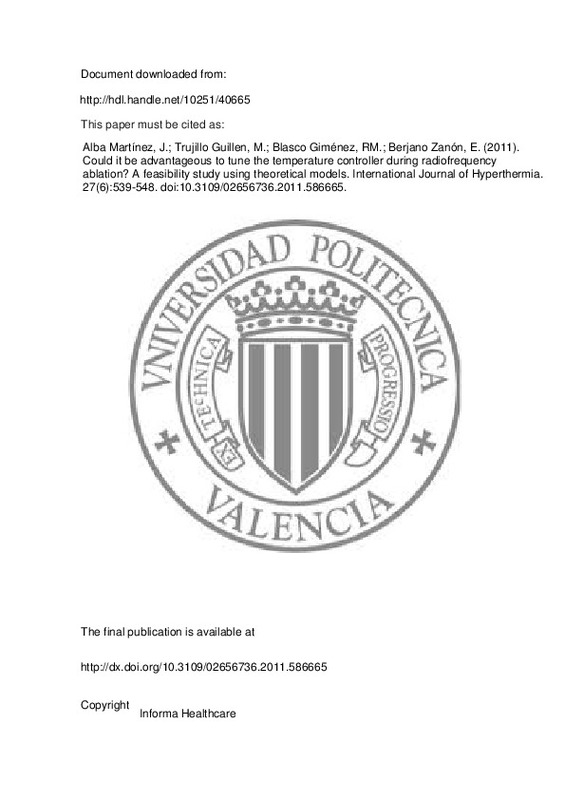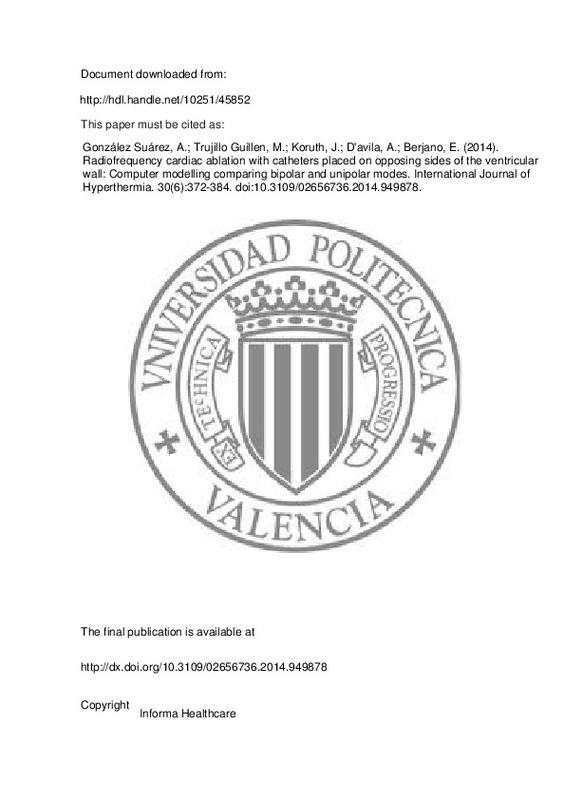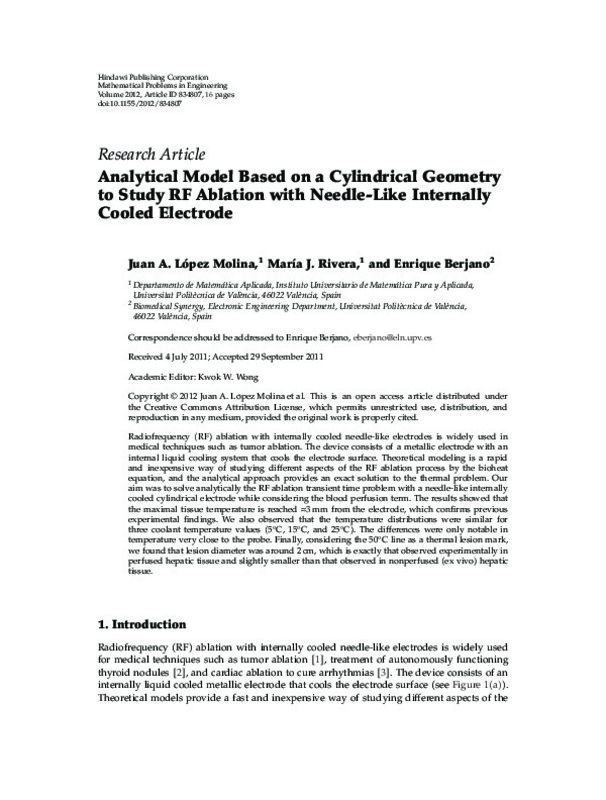Markezana, A., Ahmed, M., Kumar, G., Zorde-Khvalevsky, E., Rozenblum, N., Galun, E., & Goldberg, S. N. (2020). Moderate hyperthermic heating encountered during thermal ablation increases tumor cell activity. International Journal of Hyperthermia, 37(1), 119-129. doi:10.1080/02656736.2020.1714084
Laeseke, P. F., Lee, F. T., Sampson, L. A., van der Weide, D. W., & Brace, C. L. (2009). Microwave Ablation versus Radiofrequency Ablation in the Kidney: High-power Triaxial Antennas Create Larger Ablation Zones than Similarly Sized Internally Cooled Electrodes. Journal of Vascular and Interventional Radiology, 20(9), 1224-1229. doi:10.1016/j.jvir.2009.05.029
Andreano, A., & Brace, C. L. (2012). A Comparison of Direct Heating During Radiofrequency and Microwave Ablation in Ex Vivo Liver. CardioVascular and Interventional Radiology, 36(2), 505-511. doi:10.1007/s00270-012-0405-1
[+]
Markezana, A., Ahmed, M., Kumar, G., Zorde-Khvalevsky, E., Rozenblum, N., Galun, E., & Goldberg, S. N. (2020). Moderate hyperthermic heating encountered during thermal ablation increases tumor cell activity. International Journal of Hyperthermia, 37(1), 119-129. doi:10.1080/02656736.2020.1714084
Laeseke, P. F., Lee, F. T., Sampson, L. A., van der Weide, D. W., & Brace, C. L. (2009). Microwave Ablation versus Radiofrequency Ablation in the Kidney: High-power Triaxial Antennas Create Larger Ablation Zones than Similarly Sized Internally Cooled Electrodes. Journal of Vascular and Interventional Radiology, 20(9), 1224-1229. doi:10.1016/j.jvir.2009.05.029
Andreano, A., & Brace, C. L. (2012). A Comparison of Direct Heating During Radiofrequency and Microwave Ablation in Ex Vivo Liver. CardioVascular and Interventional Radiology, 36(2), 505-511. doi:10.1007/s00270-012-0405-1
Shi, J., & Huang, Y. (2019). Comparison of the Ablation and Hyperechoic Zones in Different Tissues Using Microwave and Radio Frequency Ablation. Journal of Ultrasound in Medicine, 38(10), 2611-2619. doi:10.1002/jum.14958
Huang, X., Nie, F., Wa, Z., Hu, H., Huang, Q., Guo, H., … Lu, M.-D. (2018). Thermal Field Distributions of Ablative Experiments Using Cyst-mimicking Phantoms. Academic Radiology, 25(5), 636-642. doi:10.1016/j.acra.2017.11.010
Shibata, T., Niinobu, T., & Ogata, N. (2000). Comparison of the effects of in-vivo thermal ablation of pig liver by microwave and radiofrequency coagulation. Journal of Hepato-Biliary-Pancreatic Surgery, 7(6), 592-598. doi:10.1007/s005340070009
Izzo, F., Granata, V., Grassi, R., Fusco, R., Palaia, R., Delrio, P., … Curley, S. A. (2019). Radiofrequency Ablation and Microwave Ablation in Liver Tumors: An Update. The Oncologist, 24(10). doi:10.1634/theoncologist.2018-0337
Liu, W., Zheng, Y., He, W., Zou, R., Qiu, J., Shen, J., … Yuan, Y. (2018). Microwave vs radiofrequency ablation for hepatocellular carcinoma within the Milan criteria: a propensity score analysis. Alimentary Pharmacology & Therapeutics, 48(6), 671-681. doi:10.1111/apt.14929
Shi, X., Pan, H., Ge, H., Li, L., … Xu, Y. (2019). Subsequent cooling-circulation after radiofrequency and microwave ablation avoids secondary indirect damage induced by residual thermal energy. Diagnostic and Interventional Radiology, 25(4), 291-297. doi:10.5152/dir.2019.17455
Dewey, W. C. (1994). Arrhenius relationships from the molecule and cell to the clinic. International Journal of Hyperthermia, 10(4), 457-483. doi:10.3109/02656739409009351
Chang, I. A., & Nguyen, U. D. (2004). Thermal modeling of lesion growth with radiofrequency ablation devices. BioMedical Engineering OnLine, 3(1). doi:10.1186/1475-925x-3-27
Trujillo, M., Bon, J., José Rivera, M., Burdío, F., & Berjano, E. (2016). Computer modelling of an impedance-controlled pulsing protocol for RF tumour ablation with a cooled electrode. International Journal of Hyperthermia, 32(8), 931-939. doi:10.1080/02656736.2016.1190868
Lopresto, V., Pinto, R., Farina, L., & Cavagnaro, M. (2017). Microwave thermal ablation: Effects of tissue properties variations on predictive models for treatment planning. Medical Engineering & Physics, 46, 63-70. doi:10.1016/j.medengphy.2017.06.008
Pätz, T., Kröger, T., & Preusser, T. (2009). Simulation of Radiofrequency Ablation Including Water Evaporation. World Congress on Medical Physics and Biomedical Engineering, September 7 - 12, 2009, Munich, Germany, 1287-1290. doi:10.1007/978-3-642-03882-2_341
Brace, C. L., Laeseke, P. F., van der Weide, D. W., & Lee, F. T. (2005). Microwave ablation with a triaxial antenna: results in ex vivo bovine liver. IEEE Transactions on Microwave Theory and Techniques, 53(1), 215-220. doi:10.1109/tmtt.2004.839308
Cavagnaro, M., Amabile, C., Bernardi, P., Pisa, S., & Tosoratti, N. (2011). A Minimally Invasive Antenna for Microwave Ablation Therapies: Design, Performances, and Experimental Assessment. IEEE Transactions on Biomedical Engineering, 58(4), 949-959. doi:10.1109/tbme.2010.2099657
Prakash, P. (2010). Theoretical Modeling for Hepatic Microwave Ablation. The Open Biomedical Engineering Journal, 4(1), 27-38. doi:10.2174/1874120701004010027
Vogl, T., Nour-Eldin, N.-E., Hammerstingl, R., Panahi, B., & Naguib, N. (2017). Microwave Ablation (MWA): Basics, Technique and Results in Primary and Metastatic Liver Neoplasms – Review Article. RöFo - Fortschritte auf dem Gebiet der Röntgenstrahlen und der bildgebenden Verfahren, 189(11), 1055-1066. doi:10.1055/s-0043-117410
Irastorza, R. M., d’ Avila, A., & Berjano, E. (2017). Thermal latency adds to lesion depth after application of high-power short-duration radiofrequency energy: Results of a computer-modeling study. Journal of Cardiovascular Electrophysiology, 29(2), 322-327. doi:10.1111/jce.13363
Irastorza, R. M., Trujillo, M., & Berjano, E. (2017). How coagulation zone size is underestimated in computer modeling of RF ablation by ignoring the cooling phase just after RF power is switched off. International Journal for Numerical Methods in Biomedical Engineering, 33(11), e2869. doi:10.1002/cnm.2869
Brace, C. L. (2009). Radiofrequency and Microwave Ablation of the Liver, Lung, Kidney, and Bone: What Are the Differences? Current Problems in Diagnostic Radiology, 38(3), 135-143. doi:10.1067/j.cpradiol.2007.10.001
Curto, S., Taj‐Eldin, M., Fairchild, D., & Prakash, P. (2015). Microwave ablation at 915 MHz vs 2.45 GHz: A theoretical and experimental investigation. Medical Physics, 42(11), 6152-6161. doi:10.1118/1.4931959
Belous, A., & Podhajsky, R. J. (2009). The effect of initial and dynamic liver conditions on RF ablation size: a study in perfused and non-perfused animal models. Energy-based Treatment of Tissue and Assessment V. doi:10.1117/12.809597
Song, K. D., Lee, M. W., Park, H. J., Cha, D. I., Kang, T. W., Lee, J., … Rhim, H. (2015). Hepatic radiofrequency ablation:in vivoandex vivocomparisons of 15-gauge (G) and 17-G internally cooled electrodes. The British Journal of Radiology, 88(1050), 20140497. doi:10.1259/bjr.20140497
Cha, J., Choi, D., Lee, M. W., Rhim, H., Kim, Y., Lim, H. K., … Park, C. K. (2009). Radiofrequency Ablation Zones in Ex Vivo Bovine and In Vivo Porcine Livers: Comparison of the Use of Internally Cooled Electrodes and Internally Cooled Wet Electrodes. CardioVascular and Interventional Radiology, 32(6), 1235-1240. doi:10.1007/s00270-009-9600-0
Solazzo, S. A., Ahmed, M., Liu, Z., Hines-Peralta, A. U., & Goldberg, S. N. (2007). High-Power Generator for Radiofrequency Ablation: Larger Electrodes and Pulsing Algorithms in Bovine ex Vivo and Porcine in Vivo Settings. Radiology, 242(3), 743-750. doi:10.1148/radiol.2423052039
Lee, J. M., Han, J. K., Chang, J. M., Chung, S. Y., Kim, S. H., Lee, J. Y., … Choi, B. I. (2006). Radiofrequency Ablation of the Porcine Liver In Vivo: Increased Coagulation with an Internally Cooled Perfusion Electrode. Academic Radiology, 13(3), 343-352. doi:10.1016/j.acra.2005.10.020
Amabile, C., Ahmed, M., Solbiati, L., Meloni, M. F., Solbiati, M., Cassarino, S., … Goldberg, S. N. (2016). Microwave ablation of primary and secondary liver tumours: ex vivo, in vivo, and clinical characterisation. International Journal of Hyperthermia, 33(1), 34-42. doi:10.1080/02656736.2016.1196830
Kuang, M., Lu, M. D., Xie, X. Y., Xu, H. X., Mo, L. Q., Liu, G. J., … Liang, J. Y. (2007). Liver Cancer: Increased Microwave Delivery to Ablation Zone with Cooled-Shaft Antenna—Experimental and Clinical Studies. Radiology, 242(3), 914-924. doi:10.1148/radiol.2423052028
He, N., Wang, W., Ji, Z., Li, C., & Huang, B. (2010). Microwave Ablation. Academic Radiology, 17(7), 894-899. doi:10.1016/j.acra.2010.03.005
Wang, Y., Sun, Y., Feng, L., Gao, Y., Ni, X., & Liang, P. (2008). Internally cooled antenna for microwave ablation: Results in ex vivo and in vivo porcine livers. European Journal of Radiology, 67(2), 357-361. doi:10.1016/j.ejrad.2007.07.015
UMEHARA, H., SEKI, T., INOKUCHI, R., TAMAI, T., KAWAMURA, R., ASAYAMA, T., … OKAZAKI, K. (2011). Microwave coagulation using a perfusion microwave electrode: Preliminary experimental study using ex vivo and in vivo liver. Experimental and Therapeutic Medicine, 3(2), 214-220. doi:10.3892/etm.2011.380
Chiang, J., Hynes, K. A., Bedoya, M., & Brace, C. L. (2013). A Dual-Slot Microwave Antenna for More Spherical Ablation Zones: Ex Vivo and in Vivo Validation. Radiology, 268(2), 382-389. doi:10.1148/radiol.13122128
Bedoya, M., del Rio, A. M., Chiang, J., & Brace, C. L. (2014). Microwave ablation energy delivery: Influence of power pulsing on ablation results in anex vivoandin vivoliver model. Medical Physics, 41(12), 123301. doi:10.1118/1.4901312
Andreano, A., Huang, Y., Meloni, M. F., Lee, F. T., & Brace, C. (2010). Microwaves create larger ablations than radiofrequency when controlled for power inex vivotissue. Medical Physics, 37(6Part1), 2967-2973. doi:10.1118/1.3432569
Cornelis, F. H., Durack, J. C., Kimm, S. Y., Wimmer, T., Coleman, J. A., Solomon, S. B., & Srimathveeravalli, G. (2017). A Comparative Study of Ablation Boundary Sharpness After Percutaneous Radiofrequency, Cryo-, Microwave, and Irreversible Electroporation Ablation in Normal Swine Liver and Kidneys. CardioVascular and Interventional Radiology, 40(10), 1600-1608. doi:10.1007/s00270-017-1692-3
Kim, H. J., Rhim, H., Lee, M. W., & Jeong, W. K. (2015). Measurement of Intrahepatic Pressure during Microwave Ablation in an Ex Vivo Bovine Liver Model. Gut and Liver, 9(6), 784. doi:10.5009/gnl14272
Faridi, P., Keselman, P., Fallahi, H., & Prakash, P. (2020). Experimental assessment of microwave ablation computational modeling with MR thermometry. Medical Physics, 47(9), 3777-3788. doi:10.1002/mp.14318
[-]












